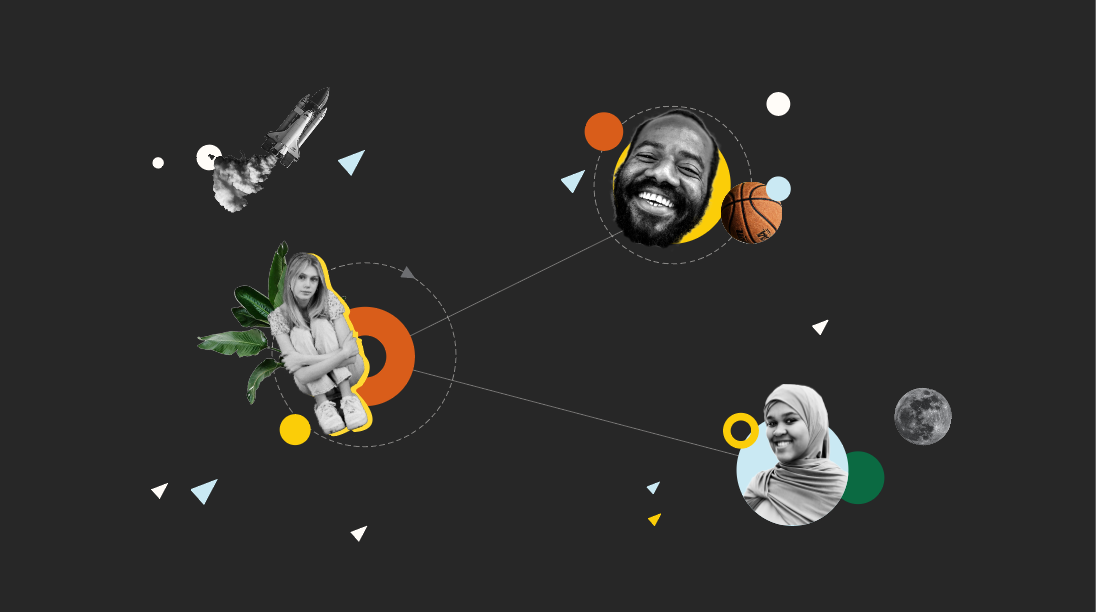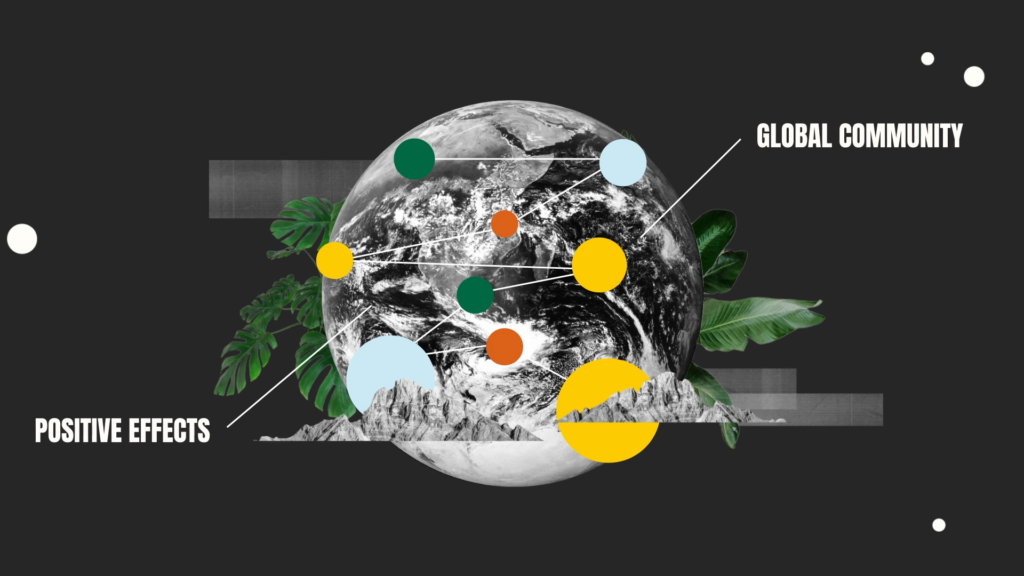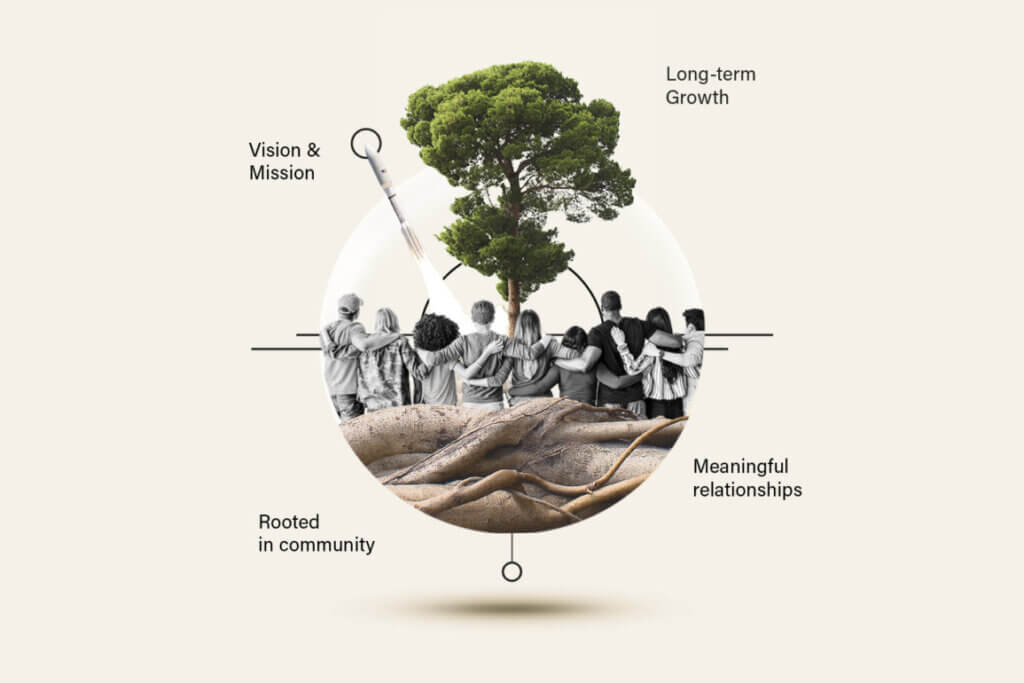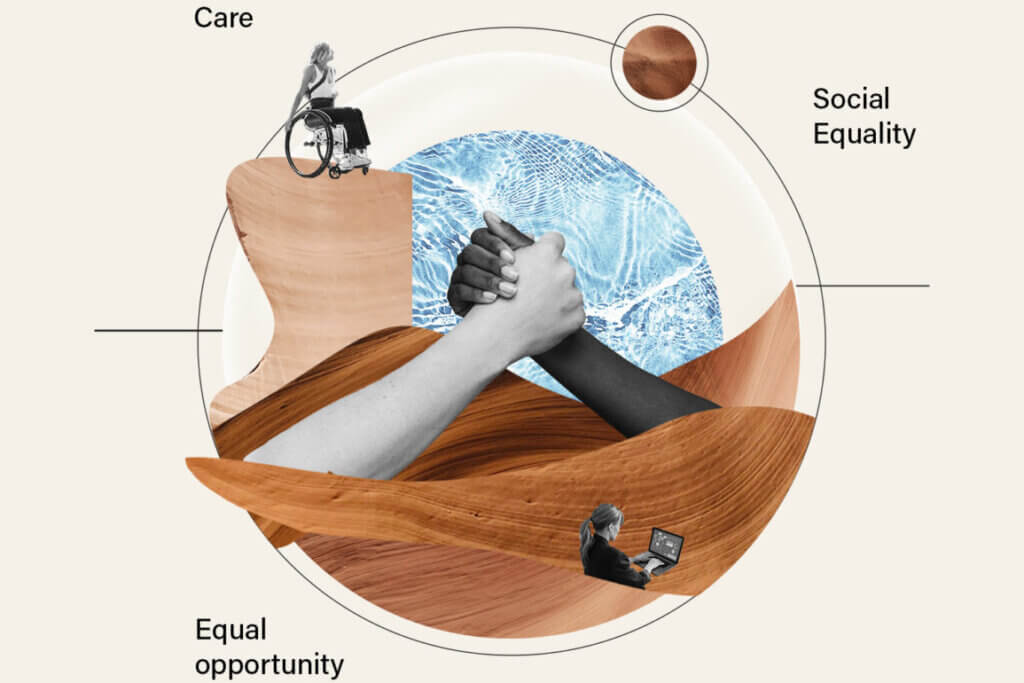What Is Stakeholder Marketing?

A new approach in tune with the world’s complexity
Today’s marketing has been built to reach one group of people: customers. As the main stakeholder who buys a business’ goods or services, they have long been the subject of marketing research—what they need, how they think, how to reach them.
In reality, businesses are supported by a complex web of communities and stakeholder groups, including ones that fall outside their assumed “target audience,” (we can talk in a different post about the use of the term target audience but for now, let’s stay focused). Different stakeholder groups have different relationships to a brand and to each other, and should not be considered in a vacuum. To the extent that a business markets to its customers without considering their context, it loses its ability to connect with that audience authentically.
Welcome to the brave new world of stakeholder marketing. It can be a corrective method to customer-focused marketing, a new approach designed for an environment in which brands no longer centrally control the message and transactions aren’t a simple two-party exchange.
Translation: a customer’s relationship with a business is influenced and mediated by other stakeholders groups. A brand’s relationship with the world is part of a system —multiple systems, in fact. An ecosystem.
So say goodbye to imagined “customer personas,” each with fixed attributes, and consider stakeholder marketing instead. This approach is for understanding and engaging with all the communities that support a business, including ones that fall outside the assumed “target audience.” Why is this so important? Doing the work of uncovering various stakeholder groups, listening to what they express, assessing their respective needs and understanding their relationship to the brand (and each other) allows a company to recognize their values while also minimizing collective harm. And that, in turn, strengthens relationships with communities and sustains relationships and ultimately success.
Stakeholder Marketing: A Definition
Stakeholder marketing is the practice of engaging communities and recognizing the needs, values and interests within, with the purpose of producing and maintaining mutually beneficial relationships across the ecosystem while also minimizing harm.
Make no mistake, engaging stakeholder marketing requires a level of thought and then action that may be intimidating to those who haven’t already done the work of mapping stakeholders, codifying community values, and establishing a valued role within their communities. According to the most comprehensive study of stakeholder marketing to date — “Stakeholder marketing: theoretical foundations and required capabilities,” published in the Journal of the Academy of Marketing Science in 2015—there are three important transitions that have occurred involving the interrelatedness of stakeholders.
These are:
- The transition from centralized to dispersed control of brand messaging
- The transition from implicit to explicit stakeholder tensions: conflicting interests can no longer be ignored, as stakeholders can now more easily organize and make themselves heard
- The transition from two-person exchanges to complex exchanges
All three of these encompass one central idea: marketing relationships do not occur between a brand and a homogeneous “persona” group or an imaged one to one relationship. Instead, they occur within emergent systems of conversation. I know what you’re thinking, Rai-mon, I see the link but seriously, what the hell is an emergent system of conversation? And I’m glad you asked because the answer is actually really important.
Emergent systems are what happens in a system that cannot happen with all the individual’s people parts of that system by themselves. It’s what greater means in the statement, greater than the sum of their parts.
Old hierarchical institutions of information and power are currently being replaced with more horizontal or flat forms of knowledge production and communication. Imagine a flock of birds changing direction en masse—or millions of people interacting on social network platforms.
“Stakeholder marketing recognizes that customer relationships may be influenced by relationships with other stakeholders and that a diverse network of stakeholders creates value,” Bas Hillebrand, Paul H. Driessen and Oliver Koll wrote in their Journal article.
Beyond the One-to-One Paradigm
Since the rise of modern marketing, the focus has been on customers and building relationships with them. In recent years, thinking in terms of “customer personas” or “user stories” has become the norm, so that businesses can segment a customer base and target marketing efforts accordingly. But the focus is still on identity, as though each customer and segment exists as homogeneous groups and are unattached to others with discrete needs and identities. This practice keeps the one to one relationships and value exchanges, between a seller and a buyer, the way most companies like it.
Stakeholder marketing moves past this old way of thinking. Hillebrand writes that stakeholder marketing “focuses on co-creation in network relationships rather than just one to one relationships and acknowledges the potential of indirect creation of value. … Stakeholder marketing recognizes that customer relationships may be influenced by relationships with other stakeholders and that a diverse network of stakeholders creates value.”
See the conversations and then actions taken in response to Colin Kaepernick by people, political parties, leagues, colleagues, brands and government as well as the social, political and financial capital created as an outflow. Very few of which were intended by the original communications between Mr. Kaepernick and the league.
None of this is to say simple one-to-one exchanges no longer exist—they do. The point is that today, in more and more stakeholder networks, exchange relationships have become complex, meaning they involve more than two parties. More and more businesses now operate in this complex world, but many (most?) still cling to the old —one-to-one—paradigm. They do so to the detriment of more powerful and meaningful relationships because the old paradigm cannot allow an accurate understanding of how the treatment of one stakeholder group or single stakeholder impacts relationships with others.
To thrive in a world full of complex exchanges, organizations must develop a new capability: community or systems thinking— which (in a marketing context) is basically an ability to understand the business’s value stream as well as its ecosystem. Marketers must gain insights into who influences whom and how, and who depends on whom and how. Only then can a business deploy meaningful strategies.
A Drastic Shift in Marketing Is Overdue
Like ecosystems in the natural world that sustain life on earth, social systems are complex. Our communities overlap, interact, expand and contract in ways that are never easy to define or measure. What may be true when observing one group in one environment may be untrue when observing another—even if certain individuals are in both groups! This may paint a picture of an extremely complex environment, but the goal is to at least make the attempt to understand it.
A company that wants to achieve sustainable success today must anticipate the needs of the ecosystem that supports its existence. To do that, brands need to understand the ecosystems they operate within by truly seeing each group of stakeholders as well as their needs, values and interests. Once seen, a map of how these individual communities overlap, interact and engage with the world around them can be visualized. Once this groundwork is laid a brand can begin to converse with their communities authentically, in an improvisational manner, helping them connect their value to the company’s values.
Does conducting stakeholder group mapping increase expectations of marketers and generally make our jobs harder? Without a doubt. But, awareness of the fact that your messages and actions have an effect on the world as a whole is the first step toward participating as a member of a global community, not to mention correcting the wrongs of the many marketers who have come before.
Brands capable of making this shift in perspective have found themselves supported by their communities (Ben & Jerrys, Patigonia, Clif Bar). Brands that don’t will make it hard on themselves in the short term and even harder on their reputations, communications efforts and bottom line in the long term.
What are Stakeholders in Marketing?
Stakeholders of all types provide feedback signals to marketers and to companies in the form of public comments and other visible measures. However, marketers traditionally only regard purchase-related feedback from those they consider to be a part of their customer base.
Marketers Traditionally Only Focus on Customer Stakeholders
Marketers perform research and make observations about customers in their industry vertical — most notably, what drives these consumers to make a purchase. The marketing team will then create a strategy in response to this information, with reference to the company’s unique branding and value proposition. If the strategy works, the target segments will make purchases as predicted. Granular data created along the customer journey, particularly within digital interactions, can inform more-specific strategies to increase prioritized key performance indicators (KPIs), such as purchase size, repeat purchases, etc.
From this limited approach, customers as a stakeholder group affect marketing through a series of feedback signals. Poor KPI performance compels marketers to try something different, while improved KPI performance encourages them to try the same strategies, perhaps with some new variations.
Other Stakeholders Can Affect Marketing, So Marketers Must Listen and Observe
But what about stakeholders outside of customers? They, too, provide feedback signals to companies regarding specific performance indicators. The only difference is that marketers are rarely, if ever, keyed into these performance indicators that exist outside their main profit-generating focus areas.
Feedback generated by employees might include:
- Turnover rate
- Average duration of employment
- Positive sentiment, as indicated by internal surveys and ratings on public platforms like Glassdoor
Companies also receive feedback from other stakeholder groups, including local communities, regulatory agencies, media coverage, and the state of the natural environment. The major difference is that this feedback is largely ignored — that is, until negative sentiment breeds deeply enough to affect the marketer’s main focus: consumers. When consumers protest about an organization’s mistreatment of employees, a history of regulatory violations, or an abysmal environmental record, it causes marketers of all stripes to sit up and take notice.
Stakeholder marketing proposes that these other stakeholder communities can affect marketing long before negative sentiment reaches a boiling point. Similar to how companies now engage various stakeholder groups in order to come up with internal initiatives for sustainability or diversity, stakeholder marketing asks that marketers acknowledge and respond to the ample feedback around them — not just when it concerns KPIs related to customer spending.
Marketing Messages Now Exist in a Complex Global Conversation

The truth that has emerged in our highly digital, highly engaged present is that marketers are entering into a complex, never-ending conversation. For all the talk of one-to-one messaging, marketers now communicate to millions of potential stakeholders at once. Accordingly, they must begin to incorporate aspects of communications, public relations, and corporate responsibility in order to be ready to absorb and respond to feedback that reveals how stakeholders think and feel.
Who Are the Stakeholders in a Businsses Ecosystem ?
The international standard intended to guide corporate social responsibility (ISO 26000) defines a stakeholder as follows: an “individual or group that has an interest in any decision or activity of an organization.”
That broad definition reveals how nearly any party, however randomly selected, might be a stakeholder because they have some sort of interest in the outcome of an organization’s activities. Notably, since just a handful of companies are responsible for the overwhelming majority of greenhouse gas pollution, it can be concluded that business activities indirectly affect every organism on the planet.
With such a broad view, organizations may feel overwhelmed at the prospect of identifying all their stakeholders. But once they begin to map the connections and rank stakeholders according to their interests and the organization’s impact on those interests, a clearer picture emerges.
Examples of stakeholders affected by the marketing ecosystem include:
- Current customers
- Prospective customers
- People socially connected to current customers
- News media
- Shareholders and investors
- Employees
- Contract labor
- Local geographic communities
- Peripheral industries and service providers, including vendors, suppliers, and other companies in the industry vertical
- Elected politicians, who serve constituents who may have opinions on the organization
- Regulatory agencies
- People who consumer news stories and social chatter about the organization and form opinions
- Those affected by emissions and other pollution generated by the organization
All of these groups form a complex network of conversation and social opinion. These stakeholders may be driven to actions that end up directly affecting the company through ways aside from increased or decreased purchases. For example, constituent complaints can compel a politician to draft legislation directly affecting the organization. Negative sentiment regarding mistreatment of employees can also cause entire geographic communities to reject the organization from expanding operations into their area.
Stakeholders vs. Shareholders: The Difference
Publicly traded companies allow any individual to purchase an equity “share” of the business on the stock market. This share is sometimes referred to as “having a stake” in the company. The collective group of individuals that owns these shares are referred to as “shareholders.”
A shareholder is an example of a stakeholder, but there is an important distinction to make. Namely: a group can have a “stake” in the decisions made or actions committed by the company without having a literal financial concern in the company itself. These individuals are referred to collectively as “stakeholders.”
This specific use of the term “stakeholder” emerged from the book Strategic Management: A Stakeholder Approach, written by Edward Freeman and published in 1984. The book sought to provoke corporate decision-makers into considering the full scope of those affected by their decisions and activities. It also proposed ranking these stakeholder groups in order of priority and the stakeholders’ abilities to impact the success of company initiatives.
What Are the Types of Stakeholders?
Stakeholders can be assigned to various categories, often with no small amount of overlap. Arranging stakeholders in this way can allow organizations to more capably assess who they impact and by how much.
Organizations can categorize stakeholders based on their relationship to the company, for example:
- Internal stakeholders include management, operations, employees, and shareholders
- Connected stakeholders are not technically part of the organization but have a direct relationship, e.g. customers, suppliers, vendors, and regulatory bodies
- External stakeholders encompass all communities not directly connected to the organization but nevertheless affected by it, e.g. the neighborhood where the business is located, news media interested in stories about corporate generosity/wrongdoing, etc.
Organizations can also rank stakeholders based on their ability to directly impact their business or be impacted by it, as follows:
- Primary stakeholders have a large impact and/or a direct relationship with the business’s primary drivers of success
- Secondary stakeholders have a medium-to-large-sized impact and have either a direct connection to the organizations’ activities or one with minimal degrees of separation
- Tertiary stakeholders have a medium-to-small impact and are only indirectly connected to the organization, but are nevertheless affected by it
These parameters can help form the basis of a scatter plot allowing organizations to identify and allocate stakeholder communities. The example below depicts a development organization assessing the stakeholders that may be concerned with their business activities and how their developments affect the region’s real estate market, job market, environmental conditions, etc.
Internal Stakeholders vs External Stakeholders
Internal stakeholders are directly involved with company operations and activities. They include direct investors as well as senior leadership staff, management, employees, and certain contractors performing activities directly for the company.
External stakeholders are, by definition, all parties that are not internal. They include customers as well as people in the geographic community, the news media, elected officials, regulatory agencies, and the environment as a whole.
Primary, Secondary Stakeholders vs Tertiary Stakeholders
Organizations can assign categories of priority to stakeholders based on the perceived value of the stakeholder and/or the stakeholder’s ability to positively or negatively impact the organization’s ability to achieve its goals.
Mapping stakeholders on a grid like the one above can allow organizations to identify high priority (primary), middle priority (secondary), and least priority (tertiary) stakeholders based on various ranking criteria.
Organizations should seek to directly address both primary and secondary stakeholders, with emphasis placed upon the former. The needs and concerns of tertiary stakeholders should be considered and incorporated into the overall messaging and marketing strategy, as well, even if they aren’t explicitly addressed or specifically targeted.
What Are Stakeholder Examples?
Here are some examples of different types of stakeholders:
Customers
Customers have the most-direct impact on corporate success and are traditionally thought of as the primary audience (or, often the sole audience) of marketing messages. Marketers must realize, however, that customer decisions and opinions are greatly influenced by other stakeholder groups.
Media
Media is driven simultaneously by profit goals, such as increasing engagement and readership/viewership, and journalistic instincts to cover important stories. Organizations that fail to incorporate media into their marketing strategy can unintentionally “become the news,” with limited control on how they are depicted.
Employees
Employees are the primary creator of value in an organization because without them the organization would cease to function. The engagement of workers is, therefore, important, as is their positive sentiment towards their organization. Employee opinions can also influence customers and garner media attention, particularly when there are allegations of mistreatment.
Government
Government entities encompass a broad range of stakeholder groups, including the citizenry writ large. Elected officials can draft legislation and policy to positively or negatively affect a business’s ability to perform as intended. Regulatory agencies may also more-closely scrutinize businesses that raise their concerns in regards to non-compliance, especially when it comes to highly public activities or messaging campaigns.
Local Community
Businesses have a physical footprint, which can positively or negatively affect local communities. Examples of positive impacts include improving employment, stimulating commerce, and providing the means for well-regarded development. Negative impacts can include pollution, workforce exploitation, real estate market manipulation, etc.
Trade and Industry Associations
Depending on the business, trade and industry associations can have a large or minimal impact on the business’s ability to succeed. Organizations with closely knit supplier communities, including business-to-business (B2B) companies, tend to have a higher need to encourage good sentiment and among trade groups. Note, however, that with all industries — even highly competitive ones — some degree of affableness is expected, or else negative opinion can spread.
Owners/Partners
Most owners are not just concerned with immediate profits but also the long-term success and overall legacy of their business. Marketing goals and strategies should reflect the intentions of the owners, including not just business goals but also aspirations for brand sentiment and long-term positioning within their vertical.
Suppliers & Vendors
Supplier/vendor relationships are key for all industries. This is especially true as organizations increase their degree of outsourcing and reliance on third-party service providers, including freelancers. Suppliers/vendors should be attracted to the prospect of doing business with the organization, and they should also reflect positively upon the organization itself.
Investors & Shareholders
Investors and shareholders have emerged as a primary stakeholder group for all companies, particularly since the late 20th century. The primary goal for most companies, now, is to maximize the chances of a positive return on investment through growth, innovation, increased market share, and profits. However, marketers and business leadership should take care to balance these goals with the needs of other stakeholders.
Creditors
Part investor, part vendor, creditors wish to maintain good relationships with businesses that can repay their debts on time and that don’t invite unnecessary risk or negative attention. Businesses eager to receive ample credit with minimal interest and terms/conditions must balance their appetite for growth with their appearance of risky or wanton decision-making.
The Environment
Because greenhouse gas emissions and other forms of pollution indirectly impact everyone on the planet, organizations are being increasingly held accountable for the sustainability and overall ethicality of their operations model, from an environmental standpoint. Negative impacts to the environment can trigger a response from any of the above groups, especially governmental groups, the media, and the public as a whole.
Why Are Marketing Stakeholders Important?
Marketing stakeholders are important precisely because they can affect the success and survival of an organization in both large and small ways.
Organizations whose marketing strategies focus only on customer relationships and revenue generation may eventually sow the seeds of a future backlash against their brand. They may also (often inadvertently) commit acts of injustice and ethical wrongdoing — or they may be accused of such unless the right messaging is visible among stakeholder groups.
Overall, each marketing stakeholder community contributes in some way to the success and longevity of the organization as a whole. By ranking them and prioritizing addressing of their needs, organizations can not only minimize harm but contribute measurable good to the various communities they impact.
Stakeholder Mapping
Stakeholder mapping is the act of identifying and then categorizing stakeholders based upon various parameters and ranking factors.
What Is a Stakeholder Map?
Many times, the stakeholder map created by the process of stakeholder mapping takes the form of a scatter plot, with the x and y axes designating specific variables like how direct of a relationship they have with the organization and how much of an impact they have on the organization’s immediate goals.
Stakeholder maps can also take the form of bar graphs, word clouds, concept drawings, and other visualizations capable of communicating the various degrees of impact each stakeholder community can have and the level of focus/priority upon the group for the organization.
How Does the Stakeholder Map Work?
Stakeholder maps using an x,y axis scatter plot individually assign qualities to each stakeholder group. These groups are then plotted on the map, according to their x and y parameters.
In most cases, the quadrant of the map the stakeholder falls in indicates their ranking or priority for the organization performing the assessment.
- Primary stakeholders (Priority 1) — Quadrant I
- Secondary stakeholders (Priority 2) — Quadrants II, IV
- Tertiary stakeholders (Priority 3) — Quadrant III
Importantly, once stakeholders are plotted to the map, those performing the assessment may decide that a certain stakeholder should be designated as more or less important than they ended up falling on the graph. They can then scrutinize their ranking factors and determine if adjustments need to be made to create a plot more closely approximating their expectations. Or, more often, they may realize that their expectations are not aligned to the reality of the situation, forcing them to reassess which stakeholder groups should be considered top priority.
Using a Stakeholder Map to Find Marketing Stakeholders
Stakeholder mapping can also be used to identify other stakeholders that exist in “in-between spaces.” For example, a scatter plot may reveal a lack of stakeholders in the second quadrant, which may groups of minimal size but outsized impact on the organization. Those performing the mapping exercise can then brainstorm to generate other stakeholders that might fall in this category.
Organizations can also create more-complex maps representing the whole ecosystem they exist in, which may resemble ecological food webs. The map may represent the entire supply chain from source to consumer. Within this map, those performing the mapping exercise may identify roles in-between those immediately considered, such as suppliers-of-suppliers.
In this way, stakeholder mapping can not only help organizations rank and prioritize known, visible stakeholders but also aid them in identifying other stakeholders that tend to “fly under the radar.”
Implementing Stakeholder-Oriented Marketing Strategies
One way to activate stakeholder marketing within your organization’s messaging strategy is to ensure that planned campaigns “tick all the boxes” to satisfy your primary and secondary stakeholder audiences.
Nearly all modern marketing campaigns start with a customer focus, which provides the basic structure of a typical campaign. With this traditional approach, marketers will be sure that the following criteria will be met:
Customer Stakeholder Demands
- The benefits of the product or service are expressly stated or directly implied
- The unique values and attributes of the brand are communicated clearly
- The aesthetic qualities of the campaign will directly appeal to targeted personas
Stakeholder marketing asks that marketers undergo the same process of uncovering requirements for all priority stakeholder groups and addresses these requirements directly. Many campaigns already do this subconsciously. For example, most campaigns have the following internal mandate:
- The campaign satisfies brand requirements and regulatory compliance
By being in alignment with branding language and corporate expectations, the campaign satisfies the need of internal stakeholders that represent leadership and also overarching branding strategy. The campaign must also meet regulatory requirements for all regions in which messaging will run, such as data collection practices related to the California Consumer Privacy Act of 2018 (CCPA).
Examples of stakeholder requirements that may be considered during the campaign planning stages, arranged by common stakeholder groups, are as follows:
Employees
- The campaign or promotion will not create an undue burden for employees, especially those at direct customer service touchpoints
- The campaign signals that workers are continually valued and will not be subject to layoffs from reorganization
- The role of workers and the value they contribute is clearly represented in the campaign
Supplies & Vendors
- Current relationships are valued and will continue to be valued
- Growth and extension of existing company services represents an opportunity for vendors’/suppliers’ simultaneous success
- The benefits of innovations and evolutions will be passed downward onto the supply chain, and vice-versa
Local Communities
- The company’s presence in the community provides a larger benefit to not just local customers but also the economy and social infrastructure at-large
- The new campaign (and existing company activities) will not negatively impact the fabric of the community as it is currently appreciated
- Growth or expansion into the community represents a positive opportunity without egregious negative tradeoffs
Elected Officials
- The campaign continues a trend of benefiting local citizens and contributing to the embetterment of society
- Regulatory stipulations and unspoken “social contract” expectations are acknowledged and embedded within the campaign’s requirements and goals
- The activities generated by the campaign will not generate a measurable public backlash requiring policy changes or a doubling down of compliance enforcement
Environmental Concerns and Other Causes
- The campaign minimizes harm to the environment
- The campaign serves to further initiatives undertaken by the company in commitment to improving sustainability and reducing environmental impact
- The campaign implicitly acknowledges the possibility of human rights violations and other concerns and takes concerted measures to actively prevent them
Types of Stakeholder Marketing Strategies
Stakeholder marketing is an evolving discipline, with the potential to take on forms as diverse and multifaceted as all the current practices in modern marketing and communications combined.
With that said, there are a few main categories of stakeholder marketing strategies to consider:
- Segmentation by stakeholder community: Running multiple campaign messaging lines according to separate stakeholder group values, expectations, and requirements
- Cause-driven marketing: De-emphasizing traditional customer appeals in order to build awareness around a brand’s efforts to address specific stakeholder concerns
- Local engagement: Engaging with communities directly through local events and outreach, while building relationships with trusted voices in the community
- Influencer marketing: Identifying influencers and respected voices in priority stakeholder groups and collaborating directly with them, or indirectly creating campaigns that appeal to influencer sensibilities to earn share-of-voice through their content
- Collaboration with internal public relations and communications: Incorporating comms and PR messaging directly into mainline marketing campaigns.
- Stakeholder community support: Creating local programs or leveraging existing ones to not just earn positive press but to also benefit communities and forge goodwill with elected officials.
- Transparency initiatives: Data tracking and publication to foster public trust and minimize narratives that the company says one thing and does another.
- Employee relations and development: Using internal employee concerns and requests to drive initiatives that later fuel messaging campaigns, while also focusing on employee development and improvement of working conditions.
Key Components of Stakeholder Theory
Stakeholder theory invokes aspects of systems thinking and conscious capitalism to develop a new, complex and holistic understanding of all the parties affected by business decisions.
The theory can be broken down into a few core concepts, as outlined below.
Simple Buyer/Seller Relationships Fail to Explain the Truth of Modern Capitalism
Stakeholder theory recognizes that there are many complex factors involved in the activities conducted by a business organization — as well as many complex consequences of those activities.
Traditional theories of market capitalism tend to flatten business relationships into two categories: a buyer, and a seller. The buyer has a demand for a good or service, and the seller can be the one to provide this good or service if they can meet the right price and the right conditions.
Modern marketing implicitly recognizes that there are far more factors involved in this equation. For one, there are countless goods and services offered in modern marketplaces that did not exist a century ago. Marketers act on the assumption that consumers will be skeptical or confused by any new offerings unless the right messaging is there to explain, persuade, and convince consumers that they do have a demand for such goods.
Under modern practice, many marketing and business strategies also recognize a critical third party: investors, and especially shareholders. Many decisions made by businesses serve to benefit the value of the company as a whole, not necessarily improve the value of products or services being offered to consumers.
For example, in response to a protracted period of relatively cheap gas prices, American car companies began to shed sedan models in favor of larger, more-popular SUV models. Regardless of existing demand for smaller sedans, the companies individually decided that growth and expansion of its most-popular products generated the most value for shareholders (a decision companies and consumers may both come to regret).
Stakeholder theory aims to uncover all of the hidden assumptions in the business equation that tend to get overlooked or abstracted away by modern business strategies.
All Stakeholders Can Impact Organizational Operations and Success
Stakeholder theory was born out of an understanding that ignoring certain factors in the marketplace — and in society at large — did not make them simply go away. Much the opposite: failing to account for stakeholder needs generates negative effects, which may reach a boiling point and come back to haunt the organization.
Author of Strategic Management: A Stakeholder Approach R. Edward Freeman comments in a 2022 reflection on his own book that by the early 1980s many companies became aware of the swirling vortex of complicated stakeholder concerns emerging in the wake of a rapidly advancing and globalizing society. Managing the external environment would soon emerge as the #1 challenge for these businesses, and this prompted a theory capable of accounting for all known parties that could have a concern, or “stake”, in the consequences of business decisions.
In other words, stakeholder theory allows for a form of “preventative medicine” that actively seeks to reduce harm and negative sentiment towards companies generated by peripheral stakeholders. Deliberately accounting for all stakeholders, inventorying their values/concerns, and then seeking to incorporate them into decision-making could reduce the risk of negative outcomes, while furthering social good with each decision made.
Knowing Is Half the Battle: The Work of Accounting Stakeholders and Their Needs Provides Intrinsic Benefits
Modern business management and strategy greatly emphasizes the need for data-based decision-making. “You can’t manage what you can’t measure” is a common refrain in this school of thought.
Stakeholder theory holds true that accounting for stakeholders and their needs provides ample data to reference and later build upon. The very act of identifying stakeholders ignored under traditional business thought yields awareness. The likelihood of making thoughtless decisions that negatively impact these groups is reduced, and the work put into accounting for each stakeholder community generates a body of knowledge that can be referred to and built upon for future business decisions.
Understanding and Addressing Stakeholder Needs Can Allow Organizations to Regain Control Over External Factors
The final premise of stakeholder theory is that stakeholders’ expectations and needs can all be managed and addressed through multi-factor strategic thinking. By incorporating all the various stakeholders into the equation, organizations can reduce the chances of disruptions and setbacks to their goals — or at very least reduce the negative impacts generated by stakeholder concerns.
The Evolution of Stakeholder Marketing Over Time
Stakeholder marketing is a relatively new field in and of itself, but it has a history that can be traced back at least 40 years. Below is a timeline of key moments in stakeholder marketing as it has emerged and evolved since the late 20th century (sourced in large part from the excellent 2011 literature review: “Stakeholder marketing: A definition and conceptual framework“)
- Mid 20th Century — Social protest movements against segregation, the Vietnam War, pollution, and other global concerns leads to boycotts, political action, and new regulations.
- 1969 — Marketing Professors Philip Kotler and Sidney J. Levy advocate for marketers to incorporate social responsibility into their thinking
- 1984 — R. Edward Freeman’s “Strategic Management: A Stakeholder Approach” is published
- 1992 — Frederick E. Webster, Jr publishes “The Changing Role of Marketing in the Corporation”, which proposes increased emphasis on customer value and relationship management
- 1998 — The paper “Market-Based Assets and Shareholder Value: A Framework for Analysis” calls upon marketers to incorporate shareholder concerns into strategy
- 2002 — Mohanbir Sawhney & Jeff Zabin research emerging trends of globalization and complex supplier/partner/employee/community networks, advocating for a more holistic and stakeholder-driven approach to corporate strategy
- Mid 2000s — Corporate social responsibility becomes a rallying cry, as criticisms over global inequities and climate change amplify
- 2004 — Isabelle Maignan & O. C. Ferrell publish “Corporate social responsibility and marketing: An integrative framework”
- 2008 — The first Stakeholder Marketing Consortium conference is held at Boston University
- 2009 — An empirical study of Fortune 1000 large companies conducted by Xueming Luo & C.B. Bhattacharya concludes that CSR initiatives improve competitiveness
- 2015 — “Stakeholder marketing: theoretical foundations and required capabilities” by Bas Hillebrand, Paul H. Driessen & Oliver Koll proposes a conceptual framework for the discipline
- 2019+ — Organizations and researchers begin to reconsider marketing from a stakeholder approach in practice, including the seminal paper “A stakeholder marketing perspective: golf’s potential to (re-)position as a health sport” by Tim Breitbarth & Christopher Huth
The Age of Completely Customer-Driven Marketing Is Over
Focusing all efforts on driving customer demand and building customer relationships above all else was once seen as the solution to business success. Over time, especially as more-complex systems emerged, what large corporations have discovered is that focus on just one stakeholder group comes almost exclusively at the expense of all others.
Ignoring stakeholders sows the seeds of later dischord and backlash, primarily because doing so inevitably furthers injustice and inequities. Businesses both large and small must come to understand that they exist not as pioneers or trailblazers in uncharted territory ripe for growth potential, but as participants in a social contract to create mutually beneficial relationships. The old thinking is extremely colonial and exploitative. The new: eye-opening, and radically empathetic.
It has been largely forgotten by history that corporations once enjoyed their privileged limited liability status exclusively by the consent of the people. Until the late 19th century, only a few select entities were granted corporate status, and these entities were expected to provide some form of public good in exchange. Over time, a series of landmark Supreme Court decisions expanded the role of corporations and granted them increasing rights in line with individuals.
Steeped in privilege and wielding incalculable global power, many businesses have strayed from the notion that they must provide some public good — aside from altruistic causes held dear by select founders or leadership personnel.
Now, however, the fact that groups outside of customers and shareholders can impact the trajectory of a business is all-too-clear. More to the point, organizations have a responsibility to understand the complex systems in which they play part and conduct themselves ethically within these systems.
Commit to Stakeholder Marketing, Commit to Social Good
Stakeholder marketing can’t transform attitudes overnight, nor can it instantly resolve social ills that result from systems that are so overwhelmingly complex, often with paradoxical needs and demands. But modern marketers exist within this framework, nonetheless. They cannot afford to ignore their role within it in favor of a simple equation where they provide goods and services in response to a specific, pre-existing demand. We know that isn’t true, and we know we can and should do better.
To learn more about applying these learnings in your organization, check out our workshops or drop us a line at hello@weareconsciously.com.














